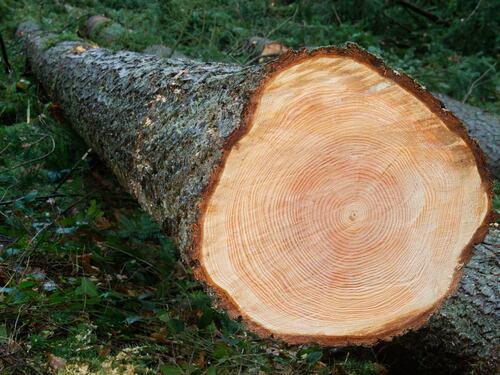Douglas Fir: Historical Preference and Modern Choice
Douglas Fir in Construction and Commercial Use
Historical Significance
Before World War II, Douglas fir was the primary construction material used in many factories, warehouses, barns, and other commercial buildings. This tree was prized for its size, strength, and durability, making it the preferred choice for a wide range of structural applications. Historically, two regional varieties of Douglas fir were used in North American buildings: coastal and interior. While both varieties share similar basic properties, coastal Douglas fir yields are notably larger, providing timber dimensions that are twice the size of those from interior trees.
Modern Utility

A Freshly Cut Douglas Fir Tree with Visible Growth Rings
Today, Douglas fir remains one of the most prolific timber producers in the world, accounting for over a quarter of all lumber used in the United States—more than any other species. Its reputation for strength and stability makes it a top choice for construction and building purposes. At Arborist Now, we understand the intrinsic value of Douglas fir and take great care in milling its wood to preserve its unique qualities.
Douglas Fir vs. Pine: A Comparison
When it comes to construction and woodworking, Douglas fir is often preferred over pine. The key difference lies in the grain structure. Douglas fir has tight, close grain lines, while pine has broader, more irregular grain lines. This difference makes pine more prone to warping, twisting, and shrinking, particularly in the soft wood between the grain lines. Douglas fir, on the other hand, is much stronger and more stable, making it less susceptible to these issues.
Reclaimed Douglas Fir Applications

Reclaimed Douglas Fir Lumber Stacked for Eco-Friendly Woodworking Projects
Douglas fir’s strength-to-weight ratio and dimensional stability make it an excellent choice for a wide range of projects, particularly those involving reclaimed wood. The wood’s ability to hold nails, screws, bolts, and plates, along with its appealing coloration that deepens with exposure to light, makes reclaimed Douglas fir a desirable material for both structural and aesthetic applications.
Reclaimed Timber
Reclaimed Douglas fir timber is a top choice for professional framers due to its size, strength, and stability. Timber harvested from old-growth forests, milled from the largest and highest-quality trees and naturally air-dried for over a century, offers exceptional stability when used in new architectural projects. These reclaimed components are often suitable for load-bearing situations without the risk of movement and shrinkage associated with freshly cut materials.
Reclaimed Dimensional Lumber
Reclaimed dimensional lumber made from Douglas fir is commonly used in framing, siding, baseboards, and window trim for both interior and exterior applications. Standard dimensions include 2″x 4-12″, 3″x 4-13″, and 4″x 6-16″. This material is valued for its strength and durability, making it ideal for various construction projects.
Reclaimed Flooring
Douglas fir flooring made from reclaimed wood offers a durable and cost-effective alternative to traditional hardwood flooring. Its strength and natural beauty make it a popular choice for those seeking a sustainable and attractive flooring option.
Glulam Beams
Beyond timber framing, Douglas fir is also an excellent material for glue-laminated beams ( glulam ). Glulam beams are created by bonding layers of dimensional lumber together with durable adhesives, resulting in a strong and moisture-resistant structural product. Douglas fir’s natural aesthetic makes it an attractive choice for exposed beams, rafters, mantles, shelves, and countertops .
The Value of Upcycling with Arborist Now

A Douglas Fir Branch with Pine Cones in a Lush Forest Setting
At Arborist Now, we are committed to the creative reuse of lumber waste materials, transforming unwanted excess into new and improved materials of equal or better quality. Upcycling in San Francisco is more than just a trend; it is a philosophy and a movement that contributes to carbon sequestration, historical preservation, and the creation of a unique local lumber resource for our community. By choosing reclaimed Douglas fir from Arborist Now, you are not only investing in high-quality materials but also supporting sustainable practices that benefit the environment and preserve our heritage.
Ready to explore the possibilities of reclaimed Douglas fir for your next project? Contact Arborist Now today to learn more about our offerings and how we can help you create something truly special.
Originally posted on November 19, 2020.


